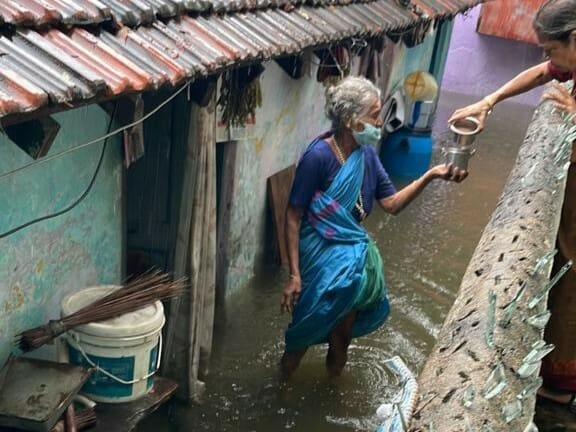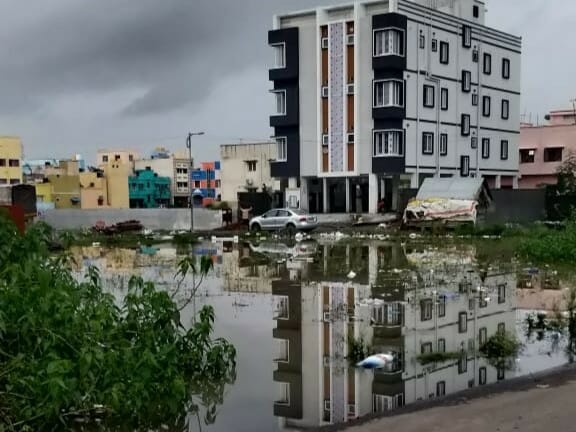While social media lauded the efforts of the civic body and state administration in preventing widespread urban flooding during the initial spell of the Northeast Monsoon, the past week also saw parts of North Chennai’s residents feel neglected in terms of response to the rains and overall flood mitigation efforts.
“If the Corporation can constantly keep vigil in core areas in Chennai like Nungambakkam, what about North Chennai? There may be so many people who are educated enough to raise complaints in the centre of the city. But North Chennai is predominantly made up of the working class, who are not aware of how to share grievances about issues due to rain on social media,” says G Logeshwaran, a resident of Thiruvotriyur. “Core areas have well-developed SWD and sewage facilities. North Chennai does not have a proper network of either.”
Zones like Madhavaram and Thiruvotriyur did not have a stormwater drain network until last year. This year, GCC has started constructing SWDs in those spots. However, the work is expected to be completed only in 2024.
Although the Chennai Corporation has taken efforts to clear the waterlogging in the subways of Ganeshapuram, Manickam Nagar and Vyasarpadi, there have been two deaths in Vyasarpadi. Two men in the area died due to electrocution in stagnated water.
We spoke to some North Chennai residents about the impact of rains in their areas.
Thiruvotriyur gets the short end of the stick
“My house is 500 metres away from the Kosasthalaiyar Basin. But when the rains are heavy, rainwater enters the homes in our area,” says Logeshwaran. Although the inundated areas naturally drain in the river in a few hours, there is no respite when it rains.
While the authorities brought pumps to take the excess water out in other areas in Chennai, Logeshwaran’s locality only saw the distribution of food items as flood relief. “Authorities came and gave us a loaf of bread; as if that will solve the waterlogging issues. There are so many spots in North Chennai where the stormwater drain has not been laid fully,” he says.
Apart from that, the Ajax subway in Thiruvotriyur was filled with water in the first few days of November. “The road was not accessible at all. To go to the other end of the subway, people now have to take an eight-kilometre detour. Even though there is a pump in the subway, the right and left sides of the way have ponds. For two days, the subway was fully inundated. On non-rainy days, workers come and desilt and pump out the water daily. I’ve now seen Chennai Corporation working on it post the recent spell of rains,” says Logeshwaran.
Read more: Chennai races against time to finish storm water drain work, but concerns persist
Other North Chennai spots also suffer in the rains
Near an urban public health centre in Pulianthope, it floods almost every time it rains, says Prabhu, a resident of Vyasarpadi. “The SWD close to it is clogged. So, I request the authorities to free up the SWD near that PHC.” Roads in Aaduthotti and Kannigapuram were also fully submerged in water during the first spell of the monsoon last week.
Apart from that, the Vyasarpadi Jeeva railway station subway was also inundated. “There were talks of a flyover there. If they expedite the process, it will be useful for us during instances when the subway is inaccessible during rains,” says Prabhu.
“In Ponniammanmedu and its neighbouring areas in Madhavaram, we do not have a sewage system. The drainage water stagnates on the roads. Moreover, there is no way for the rainwater to drain at all, due to possible clogging of SWD, despite newly constructed disposal points,” says DR Hemachandar of Madhavaram.
But some areas remained unimpacted by the initial spell of rains. “Kodungaiyur did not face a lot of damage,” says Sundar, a resident from the area.
When asked how Ennore is tackling the rains, people in the area said that most of the fishing villages have been traditionally established in higher-level areas. “Areas surrounding these villages in lower-level areas were flooded during the first week’s rains,” says Srinivasan, a resident of Ennore.
Navigating the roads in North Chennai during rains
While Logeshwaran was returning from his office on November 2nd, he met with an accident driving over potholes on Manali Express Highway, which spans from MFL Junction in Manali to Liftgate Bridge in Thiruvotriyur. He has been bruised and has injuries to his shoulder. “That road is riddled with potholes. Previous years’ monsoons must have also led to potholes on the highway, only to make matters worse this year.”
“They [authorities] did not patch the highway by laying a new one after removing the old road. Wherever holes are present, they poured tar. This has created a mound on the surface of the road. The current rains have washed away the tar, exposing the potholes again,” says Logeshwaran.
Three days before his accident, another person allegedly died in an accident in the same spot, he continues. “If there was a warning sign or red alert in that spot, I would have not suffered,” says Logeshwaran.
Spots in Thiru. Vi. Ka. Nagar see damage due to rains
Kolathur and Perambur have also come under the spotlight for waterlogging issues. “Kumaran Nagar in Kolathur faced increasing water levels that entered into houses. People were pumping out water with no help from the government,” says Hemachandar, who has family residing in Kolathur.
“On main roads, there was not a lot of waterlogging, thanks to the newly constructed SWD in Kolathur. However, some interior streets are at a lower level, making them highly prone to waterlogging. In Shanthi Nagar, drainage water was overflowing, apart from instances of rainwater entering the houses before the officials arrived with pumps to drain the water. We had to discard things from our house because they got damaged in the rain.”
Despite reaching out to GCC, there has not been any response or action to prevent a repeat of the issue during further spells expected this month says Hemachandar.
Perambur’s Ramakrishna Street was also inundated, with water entering people’s houses. “This has been the case for years,” says a resident of the area.

Read more: Looking beyond stormwater drains to realise the dream of a flood-free Chennai
Transparency could help residents to keep vigil
“Even though the civic body claims that they have taken measures to address flood mitigation, no topography study seems to have been done to identify the low-lying areas. Also, they have not revealed which low-lying areas they have identified. For instance, some areas in Pulianthope are just four metres above the mean sea level. Therefore, it is highly prone to flooding,” says Dayanand Krishnan, a Geographic Information System (GIS) expert.
“Moreover, the SWD maps put out by the GCC on its website do not clearly indicate the drain network, let alone the disposal points. In other words, it is difficult for a lay person to understand how rainwater is collected and drained in their vicinity,” he adds.
Also, the GCC website includes SWD maps for only 11 out of 15 zones, excluding Thiruvotriyur, Manali, Perungudi and Sholinganallur.
With rains being the heaviest in Thiru. Vi. Ka. Nagar and Thiruvotriyur, which received 353.1 mm and 328.3 mm rainfall respectively in the first days of the the monsoon this year, the grievances of residents from various areas of North Chennai must be addressed on priority to prevent further spells causing widespread damage.
For flood-related grievances, call 1913, Chennai Corporation’s toll-free number. Apart from that, they can be reached at 044 25619206, 044 25619207, 044 25619208.
